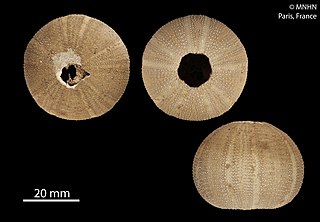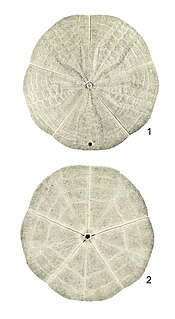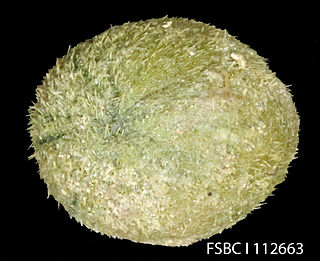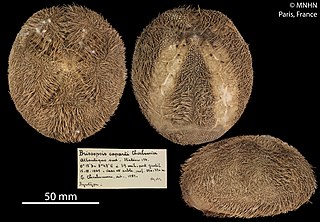Arachnoides is a genus of sea urchin within the family Clypeasteridae, found in the Indo-Pacific oceans. The base is flat and the upper surface is convex.

Echinus tylodes is a species of sea urchin in the Echinidae family. It is white with rather sparse pink spines, and is endemic to the eastern coast of North America including the Gulf of Mexico.

The Echinothurioida are an order of sea urchins in the class Echinoidea. Echinothurioids are distinguished from other sea urchins by the combination of a flexible test and hollow spines. The membrane around the mouth contains only simple plates, in contrast to the more complex mouth parts of their close relatives, the Diadematoida. They are nearly all deepsea dwellers.

Neritopsis is a genus of sea snails in the family Neritopsidae.

Amblypneustes pallidus is a species of sea urchin of the family Temnopleuridae. Their armour is covered with spines. It came from the genus Amblypneustes and lives in the sea. Amblypneustes pallidus was first scientifically described in 1816 by Jean-Baptiste de Lamarck.
Ammotrophus arachnoides is a species of sand dollar of the family Arachnoididea. Their external skeleton, known as a test, is covered with spines. It belongs to the genus Ammotrophus and lives in the sea off southern Australia. Ammotrophus arachnoides was first scientifically described in 1938 by Hubert Clark.
Ammotrophus cyclius is a species of sand dollar of the family Arachnoididae. Their external skeleton, known as a test, is covered with spines. It belongs to the genus Ammotrophus and lives in the seas off southern Australia. Ammotrophus cyclius was first scientifically described in 1928 by Hubert Clark.
Ammotrophus platyterus is a species of sea urchin of the family Temnopleuridae. Their armour is covered with spines. It came from the genus Ammotrophus and lives in the sea. Ammotrophus platyterus was first scientifically described in 1928 by Hubert Clark.

Aporocidaris usarpi is a species of sea urchin of the family Ctenocidaridae. Their armour is covered with spines. It is placed in the genus Aporocidaris and lives in the sea. Aporocidaris usarpi was first scientifically described in 2000 by Mooi, David, Fell & Choné.

Arachnoides placenta is a species of sea urchin of the family Clypeasteridae. Their armour is covered with spines. It is placed in the genus Arachnoides and lives in the sea. Arachnoides placenta was first scientifically described in 1758 by Carl Linnaeus.

Arachnoides tenuis is a species of sea urchin of the family Clypeasteridae. Their armour is covered with spines. It is placed in the genus Arachnoides and lives in the sea. Arachnoides tenuis was first scientifically described in 1938 by Hubert Lyman Clark.
Araeosoma alternatum is a species of sea urchin of the family Echinothuriidae. Their armour is covered with spines. It is placed in the genus Araeosoma and lives in the sea. Araeosoma alternatum was first scientifically described in 1934 by Ole Theodor Jensen Mortensen, a Danish zoologist.
Araeosoma belli is a species of sea urchin of the family Echinothuriidae. Their armour is covered with spines. It is placed in the genus Araeosoma and is found throughout the Caribbean Sea as well as areas around the Gulf of Mexico. Araeosoma belli was first scientifically described in 1903 by Ole Theodor Jensen Mortensen, a Danish zoologist.
Phormosoma placenta is a species of sea urchin in the order Echinothurioida. It is a deepwater species, seldom being found at depths less than 500 m (1,600 ft), and occurs on either side of the Atlantic Ocean on the continental slope.
Austrocidaris pawsoni is a species of sea urchins of the Family Cidaridae. Their armour is covered with spines. Austrocidaris pawsoni was first scientifically described in 1974 by McKnight.

Brissopsis alta is a species of sea urchins of the Family Brissidae. Their armour is covered with spines. Brissopsis alta was first scientifically described in 1907 by Ole Mortensen.
Brissopsis atlantica is a species of sea urchin of the Family Brissidae. Their armour is covered with spines. Brissopsis atlantica was first scientifically described in 1907 by Ole Theodor Jensen Mortensen.
Brissopsis bengalensis is a species of sea urchins of the Family Brissidae. Their armour is covered with spines. Brissopsis bengalensis was first scientifically described in 1914 by Koehler.

Brissopsis caparti is a species of sea urchins of the Family Brissidae. Their armour is covered with spines. Brissopsis caparti was first scientifically described in 1959 by Cherbonnier.

Clypeasteridae is a family of sea urchins in the order Clypeasteroida. This family was first scientifically described in 1835 by the Swiss-American biologist Louis Agassiz.











